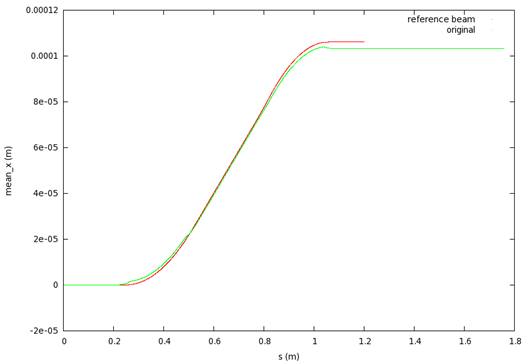opal AT lists.psi.ch
Subject: The OPAL Discussion Forum
List archive
- From: Philippe Piot <piot AT nicadd.niu.edu>
- To: "Snuverink Jochem (PSI)" <jochem.snuverink AT psi.ch>
- Cc: "piot AT nicadd.niu.edu" <piot AT nicadd.niu.edu>, "opal AT lists.psi.ch" <opal AT lists.psi.ch>
- Subject: Re: [Opal] trajectory through a simple two-rbend dogleg
- Date: Mon, 6 Jan 2020 05:58:32 -0600
https://www.niu.edu/advanced-accelerator-randd/
Northern Illinois University, Dept of Physics and
Northern Illinois Center for Accelerator & Detector Development
DeKalb, IL 60115, USA
Tel: 815 753 6473, Web: http://www.physics.niu.edu/physics/
Argonne National Laboratory, Advanced Photon Source
Accelerator System Division
Dear Philippe Piot,
I believe this is due to the fact that OPAL tracks the particles per time step and consequently records the properties for a given time (and not for a given z-position) in the output ‘stat’ file. The s-position in the output is the distance the bunch travelled at a given time, and mean_x is also the mean x-position at a given time (not a given position).
As you have a finite beam size in x,y and z, at a given time, the particles will not have the same longitudinal position and they don’t enter the bend at the same time, leading to the (still smooth) curve you see. If I track with a zero beam size, the trajectory is as you might expect:
To record the particles at a given position, one can use the MONITOR element (in OPAL-T).
Hope that helps,
Jochem
From: opal-request AT lists.psi.ch <opal-request AT lists.psi.ch> On Behalf Of Philippe Piot
Sent: Freitag, 3. Januar 2020 12:40
To: opal AT lists.psi.ch
Subject: [Opal] trajectory through a simple two-rbend dogleg
All,
I have set up a simple dogleg (see input attached) and cannot understand the trajectory (display below as s versus mean_x. It has kinks at the entrance and exit for both dipoles (at s~0.25, 0.5, 0.75 and 1 m) which seem to coincide with the fringe field region. Is this an artifact due to the way the statistical parameters are computed? or something wrong with my model. Thank you, -- Philippe.
Philippe Piot,
https://www.niu.edu/advanced-accelerator-randd/
Northern Illinois University, Dept of Physics and
Northern Illinois Center for Accelerator & Detector Development
DeKalb, IL 60115, USA
Tel: 815 753 6473, Web: http://www.physics.niu.edu/physics/
Argonne National Laboratory, Advanced Photon Source
Accelerator System DivisionLemont, IL 60439, USA
Tel: 630 252 2415, Web: https://www.aps.anl.gov/Accelerator-Systems-Division
- [Opal] trajectory through a simple two-rbend dogleg, Philippe Piot, 01/03/2020
- RE: [Opal] trajectory through a simple two-rbend dogleg, Snuverink Jochem (PSI), 01/06/2020
- Re: [Opal] trajectory through a simple two-rbend dogleg, Philippe Piot, 01/06/2020
- RE: [Opal] trajectory through a simple two-rbend dogleg, Snuverink Jochem (PSI), 01/06/2020
Archive powered by MHonArc 2.6.19.

